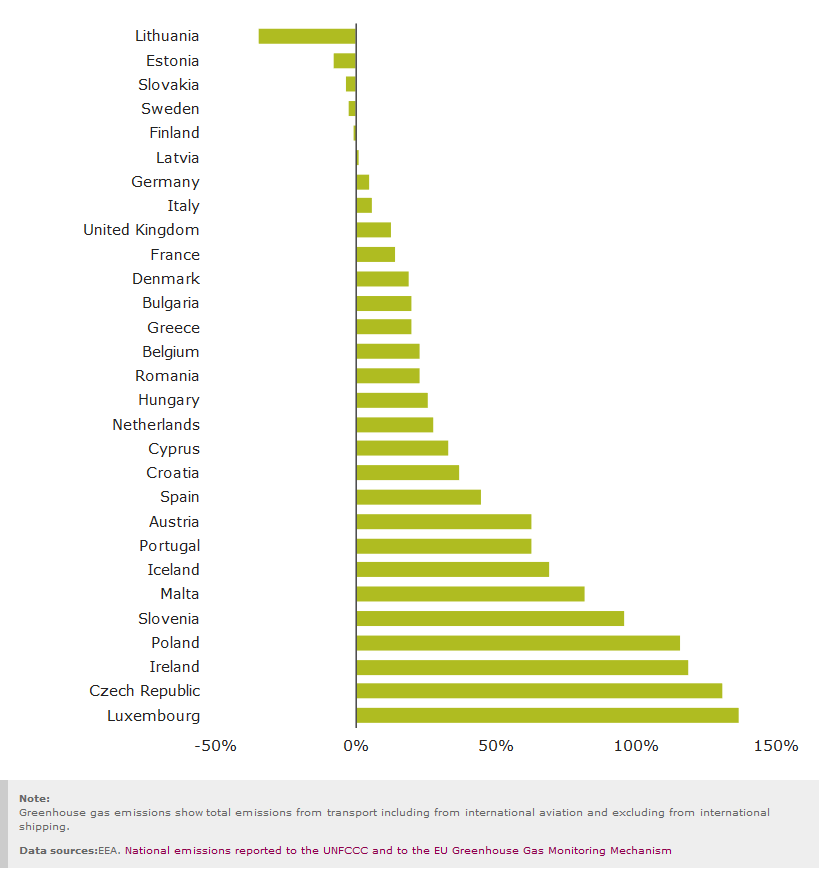|
Indicator
|
EU indicator past trend
|
Selected objective to be met by 2020
|
Indicative outlook of the EU meeting the selected objective by 2020
|
|
Greenhouse gas emissions from transport
|

|
Reduce the overall environmental impact of production and consumption in the mobility sector - 7th EAP
|

|
|
Past transport greenhouse gas emissions increased from 1990 to 2014 despite a decline between 2008 and 2013. It is uncertain if emissions will reduce by 2020, since according to projections by the EU Member States emissions will remain more or less stable between 2015 and 2020
|
For further information on the scoreboard methodology please see Box I.1 in the EEA Environmental indicator report 2016
Setting the scene
The 7th EAP calls for a reduction in the environmental impact of mobility (EU, 2013). Transport (i.e. mobility) is a major contributor to climate change, air pollution, noise, natural resource depletion and land fragmentation. Reducing the environmental impact of transport is usually done by reducing the demand for travel, introducing new, cleaner technologies and shifting towards less environmentally damaging transport modes. Greenhouse gas emissions from the transport sector have been used in this briefing as a proxy indicator for the overall environmental impacts of the transport sector. These emissions reflect the level and efficiency of the sector’s activity as well as the mix of transport modes. In addition, climate change (and therefore greenhouse gas emissions) is one of the most significant environmental issues, and transport contributes about one quarter of the EU’s total greenhouse gas emissions.
Policy targets and progress
In 2011, the European Commission published a White Paper on transport entitled Roadmap to a Single European Transport Area — Towards a competitive and resource efficient transport system (EC, 2011). It acts as a framework to guide future policy developments in the transport sector over the next decade. The White Paper sets out 10 goals for a competitive and resource-efficient transport system, serving as benchmarks for achieving the target of a 60 % reduction in greenhouse gas emissions from the EU transport sector by 2050 (from 1990 levels).
From 1990 to 2014, greenhouse gas emissions from transport increased by 20.1 % compared with 1990 levels (see Figure 1). This increase comes despite improvements in the efficiency of transport and is in line with increases in the level of economic activity as measured by gross domestic product (GDP) as well as increases in demand for transport (both freight and passenger) (EEA, 2016a, 2016b).
Nevertheless, emissions decreased from 2008 to 2013, in part because of the lower levels of economic activity — manifesting also in lower levels of freight transport (EEA, 2016b) — following the 2008 economic downturn, as well as further implementation of transport efficiency measures.
Road transport accounts for 72 % of the total greenhouse gas emissions of the sector (EEA, 2016c). Energy efficiency improvements in road transport played a key role in limiting the increase of road transport emissions. Such improvements were brought about in part by means of increasingly stringent technical standards, including the average CO2 emission standards for new passenger cars (EU, 2009) and vans (EU, 2011). The increased use of less carbon-intensive fuels, such as liquefied petroleum gas (LPG) and biofuel blends, has also led to lower road transport emissions (EEA, 2015).
It is uncertain if transport greenhouse gas emissions will reduce by 2020, since according to projections by the EU Member States, emissions for the EU (including international aviation but excluding international shipping) will remain more or less stable between 2015 and 2020 in both scenarios: with existing measures and with additional measures (EEA, 2016d, 2016e). Preliminary estimates for 2015 emissions show, nevertheless, an increase of 2.3 % above 2014 levels (EEA, 2016f).
Country level information

Outlook beyond 2020
The 10 goals set by the European Commission White Paper on Transport (EC, 2011) are expected to lead to the future introduction of new EU policies to increase the efficiency of Europe’s transport sector. The main target of the White Paper is to reduce greenhouse gas emissions to 40 % of 1990 levels by 2050. A key assumption in the White Paper is that technologies that contribute to lower greenhouse gas emissions will be increasingly available, especially after 2030, such as the electrification of transport and more intensive use of advanced biofuels.
A modal shift away from road transport is also a key element of the EU’s decarbonisation ambitions. The White Paper explicitly states the ambition to shift 30 % of road transport for distances over 300 km to rail and inland navigation by 2030, and more than 50 % by 2050.
Nevertheless, total transport demand is predicted to continue growing during the 2020–2030 period in line with the 2010–2020 patterns (1 % a year for passenger transport (passenger km) and 1.5 % for freight transport (tonne km)) and at lower rates between 2030 and 2050 (0.7 % a year for passenger transport and 0.8 % for freight transport) (EC, 2016).
Integrated measures addressing both production and consumption would therefore be needed in the long run in order to, inter alia, contain the expected increase in transport demand and reduce the greenhouse gas emissions from transport by 60 % by 2050.
About the indicator
This indicator presents the total EU greenhouse gas emissions from transport including emissions from international aviation but excluding emissions from international maritime transport. Greenhouse gas emissions include carbon dioxide, methane and nitrous oxide. The individual gases were converted into greenhouse gas emissions by being weighted according to their global warming potentials following the relevant guidelines of the Intergovernmental Panel on Climate Change. For further information on the indicator and on the method used, please see the indicator specification of the EEA indicator TERM (Transport and Environment Reporting Mechanism) 002 (EEA, 2016g).
The indicator does not include greenhouse gas emissions from the construction of transport-related infrastructure or from the production of transport vehicles within and outside the EU.
Document Actions
Share with others